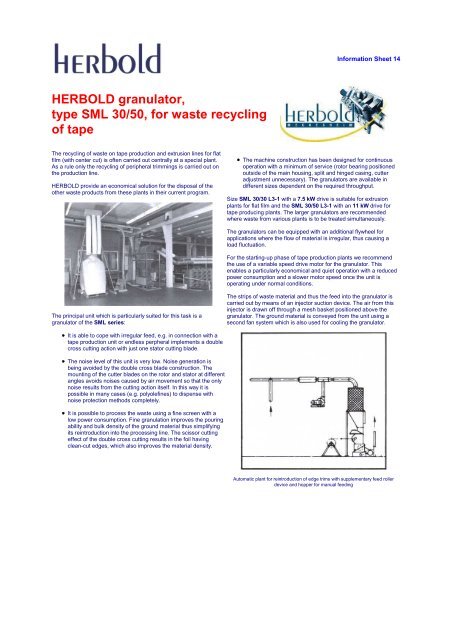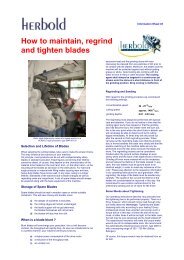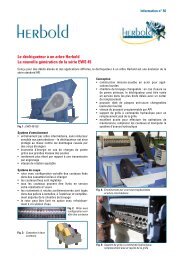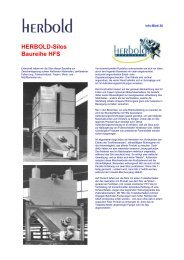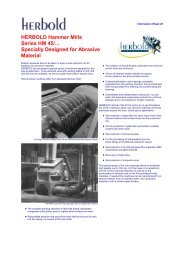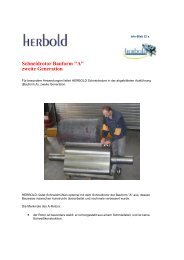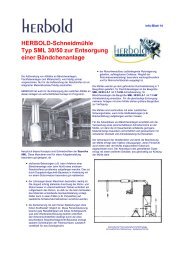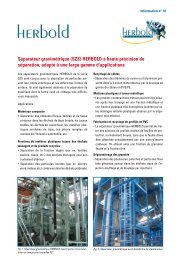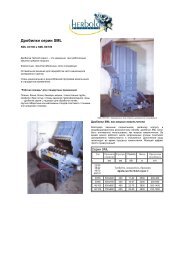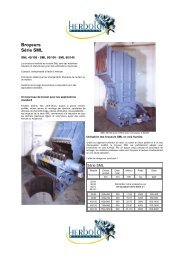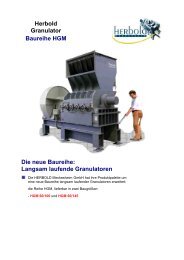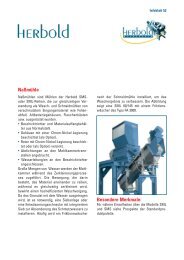Information Sheet 14: "HERBOLD granulators, type SML 30/50" -...
Information Sheet 14: "HERBOLD granulators, type SML 30/50" -...
Information Sheet 14: "HERBOLD granulators, type SML 30/50" -...
You also want an ePaper? Increase the reach of your titles
YUMPU automatically turns print PDFs into web optimized ePapers that Google loves.
<strong>Information</strong> <strong>Sheet</strong> <strong>14</strong><br />
<strong>HERBOLD</strong> granulator,<br />
<strong>type</strong> <strong>SML</strong> <strong>30</strong>/50, for waste recycling<br />
of tape<br />
The recycling of waste on tape production and extrusion lines for flat<br />
film (with center cut) is often carried out centrally at a special plant.<br />
As a rule only the recycling of peripheral trimmings is carried out on<br />
the production line.<br />
<strong>HERBOLD</strong> provide an economical solution for the disposal of the<br />
other waste products from these plants in their current program.<br />
The machine construction has been designed for continuous<br />
operation with a minimum of service (rotor bearing positioned<br />
outside of the main housing, split and hinged casing, cutter<br />
adjustment unnecessary). The <strong>granulators</strong> are available in<br />
different sizes dependent on the required throughput.<br />
Size <strong>SML</strong> <strong>30</strong>/<strong>30</strong> L3-1 with a 7.5 kW drive is suitable for extrusion<br />
plants for flat film and the <strong>SML</strong> <strong>30</strong>/50 L3-1 with an 11 kW drive for<br />
tape producing plants. The larger <strong>granulators</strong> are recommended<br />
where waste from various plants is to be treated simultaneously.<br />
The <strong>granulators</strong> can be equipped with an additional flywheel for<br />
applications where the flow of material is irregular, thus causing a<br />
load fluctuation.<br />
For the starting-up phase of tape production plants we recommend<br />
the use of a variable speed drive motor for the granulator. This<br />
enables a particularly economical and quiet operation with a reduced<br />
power consumption and a slower motor speed once the unit is<br />
operating under normal conditions.<br />
The principal unit which is particularly suited for this task is a<br />
granulator of the <strong>SML</strong> series:<br />
The strips of waste material and thus the feed into the granulator is<br />
carried out by means of an injector suction device. The air from this<br />
injector is drawn off through a mesh basket positioned above the<br />
granulator. The ground material is conveyed from the unit using a<br />
second fan system which is also used for cooling the granulator.<br />
It is able to cope with irregular feed, e.g. in connection with a<br />
tape production unit or endless perpheral implements a double<br />
cross cutting action with just one stator cutting blade.<br />
The noise level of this unit is very low. Noise generation is<br />
being avoided by the double cross blade construction. The<br />
mounting of the cutter blades on the rotor and stator at different<br />
angles avoids noises caused by air movement so that the only<br />
noise results from the cutting action itself. In this way it is<br />
possible in many cases (e.g. polyolefines) to dispense with<br />
noise protection methods completely.<br />
It is possible to process the waste using a fine screen with a<br />
low power consumption. Fine granulation improves the pouring<br />
ability and bulk density of the ground material thus simplifying<br />
its reintroduction into the processing line. The scissor cutting<br />
effect of the double cross cutting results in the foil having<br />
clean-cut edges, which also improves the material density.<br />
Automatic plant for reintroduction of edge trims with supplementary feed roller<br />
device and hopper for manual feeding
The described conveyor and size reduction units operate completely automatically<br />
and trouble-free. Since the material is directly being fed back into the production<br />
process there is no need for any intermediate storge whatsoever. This ensures that<br />
the material reaches the processing plant in a perfectly clean condition.<br />
Fine processing resulting in a product of high bulk density makes it possible to<br />
directly feed the material into an extruder. To this purpose, a cyclone separator can<br />
be fitted between the granulator and the extruder. New granules can then be fed<br />
through the cyclone air intake into the extruder and mixed in the required<br />
proportions with the freshly ground waste.<br />
In cases where there is no consistent flow of the waste material a storage container<br />
can be installed.<br />
A pneumatic conveying device can also be used for transporting the waste to a<br />
central recycling plant.<br />
Ñ«® °®±¼«½¬ ®¿²¹»<br />
{ Ù®¿²«´¿¬±®<br />
{ Ы´ª»®·¦·²¹ ͧ¬»³<br />
{ ͸®»¼¼»®<br />
{ Ø¿³³»® Ó·´´<br />
{ ØÑ٠͸®»¼¼»®<br />
{ Ù«·´´±¬·²»<br />
{ É¿¸·²¹ ͧ¬»³<br />
{ д¿¬½±³°¿½¬±®<br />
Ø»®¾±´¼ Ó»½µ»¸»·³ Ù³¾Ø<br />
ײ¼«¬®·»¬®ò íí<br />
Üóéìçðç Ó»½µ»¸»·³<br />
б¬º¿½¸ ïîïè<br />
Üóéìçðè Ó»½µ»¸»·³<br />
Ì»´òæ õ ìç øð÷ êîîêñçíîóð<br />
Ú¿¨æ õ ìç øð÷ êîîêñçíîóìçë<br />
ÛóÓ¿·´æ Ø»®¾±´¼àØ»®¾±´¼ò½±³<br />
ײ¬»®²»¬æ ©©©òØ»®¾±´¼ò½±³<br />
Í°»½·º·½¿¬·±² ¿®» ²±¬ ¾·²¼·²¹ ¿²¼ «¾»½¬ ¬± ½¸¿²¹» ©·¬¸±«¬ ²±¬·½»ò Û¼·¬·±² ðëñîððé<br />
Ñ«® ËÍóÍ«¾·¼·¿®§æ<br />
Ø»®¾±´¼ Ó»½µ»¸»·³ ËÍß<br />
뱫®½» 뽧½´·²¹ ͧ¬»³ ײ½ò<br />
ííí Ù»±®¹» É¿¸·²¹¬±² Ø·¹¸©¿§ô<br />
ËÍßóͳ·¬¸º·»´¼ô<br />
θ±¼» ×´¿²¼ ðîçïé<br />
и±²»æ õ ï ìðïóîíîóííëì<br />
Ú¿¨æ õ ï ìðïóîíîóëìîë<br />
·²º±àØ»®¾±´¼ËÍßò²»¬<br />
©©©òØ»®¾±´¼ËÍßò²»¬


